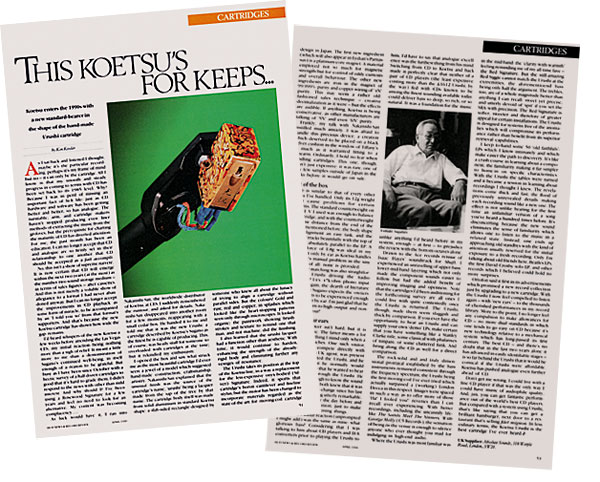This Koetsu's for keeps... Page 2
...And Into Your Ears
Life as a reviewer can mean a lot of visitors, something I mind only when a deadline approaches. One such visitor, whose products compete directly with those of Koetsu's UK agent, was present the day after I fitted the Urushi, and he stayed longer that he normally would have.
The reason is that he wanted to hear more and more through the Urushi. He visits me often enough to know the sound of my system, so we both knew that it was the Urushi (the only change since his last visit) doing something utterly remarkable. I'd been reeling since the day before and welcomed a second opinion, if only just to make certain that I wasn't imagining things.
My guest's reaction (unprompted I might add) was the same as mine: what glorious bass! Switching from CD to Koetsu and back made it perfectly clear that neither of a pair of CD players (the less expensive costing more than the £1612 Urushi, by the way) fed with CDs known to be among the finest sounding available today could deliver bass so deep, so rich, or so natural. It was a foundation for the music unlike anything I'd heard before in my system, enough – at first – to prejudice the review with the bottom octaves alone.

Drawn to the Ace records reissue of Isaac Hayes' soundtrack for Shaft, I experienced an unravelling of upper-bass lower-midband layering which not only made the component sounds easier to follow but had the added benefit of improving imaging and openness. Note that the cartridges I'd been auditioning for the forthcoming survey are all ones I could live with quite contentedly once the Urushi is returned. The Urushi though made them seem sluggish and thick by comparison.
If you ever have the opportunity to hear an Urushi and can supply your own 'demo' LPs, make certain that you have something like a Stanley Clarke title, some classical with phalanxes of timpani, or some cluttered funk. And bring along the CD as well for a direct comparison.
The rock-solid and truly three-dimensional protrayal established by the bass instruments remained consistent through the frequency spectrum; the Urushi being the first moving-coil I've ever tried which actually surpassed a (working) London Decca in this particular respect. Images were spaced in such a way as to offer far more of those 'Ha! I fooled you!' reveries than I can recall ever experiencing.
With better recordings, including the uncannily lifelike The Saints Meet The Sinners, With George Melly [C5 Records], the sensation of being in the venue is enough to silence anyone who ever thought you mad for indulging in high-end audio.
Fresh Ears
Where the Urushi was most familiar was in the midband: the 'clarity-with-warmth' feeling reminding me of my all-time fave – the Koetsu Red Signature. But the still-amazing Red Siggie cannot match the Urushi at the extremities, the aforementioned bass being only half the argument. The trebles, too, are of a whole magnitude better than anything I can recall, being sweet yet precise, and utterly devoid of 'spit' if you set the SRA with precision.
The Red Signature is softer, sweeter and therefore of greater appeal for certain installations. The Urushi is designed for systems free of the anomalies which will compromise its performance rather than benefit from its superior retrieval capabilities.
I keep to hand some 50 'old faithfuls': LPs that I know intimately and which make easier the path to discovery. It's like a crash course in learning about a component, the familiarity making it far simpler to home-in on specific characteristics.
With the Urushi the tables were turned and it became a session in learning about recordings I thought I knew. The revelations come thick and fast, the flood of previously unrevealed details making each recording sound like a new one.
The effect is not unlike hearing for the first time an unfamiliar version of a song you've heard a hundred times before. It's disconcerting because the new sound eliminates the sense of familiarity which allows one to listen to the music in a relaxed state. Instead, one ends up approaching old standbys with the kind of attention usually reserved for the initial exposure to a fresh recording. Only I'm talking about old friends here, a selection of Beatles LPs, the first David Crosby solo LP, and other records which I believed could hold no more surprises.
Ortofon said it first in its ads which promised a new record collection just by upgrading to a new cartridge. With the Urushi I now feel compelled to listen again – with 'new ears' – to the thousands of cherished performances in my record library. More to the point, I no longer feel any compulsion to make allowance for CD – no more dual standards in which one tends to go easy on CD because it's new technology relative to a mechanical system which has long-passed its first century. The best CD – and in the last two years alone it has advanced in easily identifiable stages – is so far behind the Urushi that it would be comical if the Urushi were affordable. Koetsu has pushed analogue even further ahead of CD.
What's Your Beef?
Don't get me wrong. I could live with a fine CD player if that was the only way I could have music of audiophile quality. And, yes, you can get fantastic performance out of the world's best CD players. But compared with a system using the Urushi, that's like saying that you can get a brilliant hamburger, next door to a restaurant that's selling filet mignon. In less culinary terms, the Koetsu Urushi is the best cartridge I've ever heard.
























































